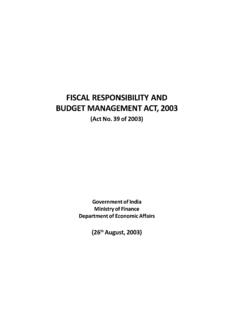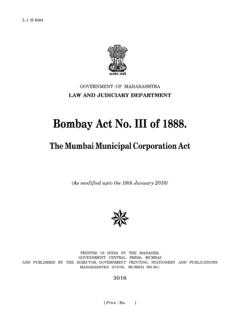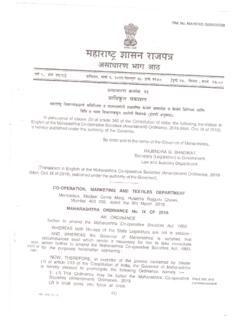Transcription of Report of the Task Force Department of Economic Affairs ...
1 1 National Infrastructure PipelineReport of the Task ForceDepartment of Economic AffairsMinistry of FinanceGovernment of IndiaVolume I23 ContentsTask Force Members and Terms of Reference 11 Acknowledgements 12 Infrastructure Vision 2025 and Goals 15 National Infrastructure Pipeline 25 Annexure 1: KPI Framework 43 Annexure 2: Governance Framework with Escalation Matrix 534 List of FiguresFigure 1 GDP in PPP terms ($ trillion) 15 Figure 2 Annual average growth rate (%) 15 Figure 3 Trend in India s population and urbanisation 17 Figure 4 Growing working-age population 18 Figure 5 Contribution of urban and rural areas to total employment in India 18 Figure 6 Infrastructure Vision 2025.
2 Meeting aspirations, propelling growth and improving ease of living 21 Figure 7 India s infrastructure investment trend since fiscal 2013 (Rs lakh crore) 26 Figure 8 Sector-wise share (%) in infrastructure investment of Rs 57 lakh crore during fiscals 2013 to 2019 27 Figure 9 Key benefits of NIP 31 Figure 10 Constituents of NIP 32 Figure 11 Sector-wise break-up of capital expenditure of Rs 111 lakh crore during fiscals 2020-2025 35 Figure 12 Share of Centre, state and private sector in the NIP 36 Figure 13 Stage of implementation 365 List of TablesTable 1 First pillar of Global Competitiveness Index Institutions 28 Table 2 Second pillar of Global Competitiveness Index - Infrastructure 29 Table 3 Sector-wise annual capital expenditure in infrastructure (Rs crore) 33 Table 4 Elements of Monitoring and Evaluation Framework 416 Abbreviations and AcronymsAAIA irports Authority of IndiaACSA verage cost of supplyAIArtificial intelligence AERAA irport Economic Regulatory AuthorityAGRA djusted gross revenueAISHEAll India Survey on Higher EducationAMRUT Atal Mission for Rejuvenation and Urban Transformation APDRP Accelerated Power Development and Reforms Programme APLMA gricultural Produce and Livestock MarketingAPMCA gricultural Produce Marketing CommitteeAPMIPA ndhra Pradesh Micro Irrigation ProjectARRA verage revenue realisedASERA nnual Status of Education ReportASQA irport service qualityAT&C Aggregate technical & commercial AT FAviation turbine fuelAUMA ssets under managementBGFI Bond Guarantee Fund of India 7 BISB ureau of Indian StandardsBITBump integrator testB LTBuild-lease-transferBOLTB uild-own-lease-transferBOOB
3 Uild, own and operateBOOTB uild, own, operate and transferCAGRC ompound annual growth rateCCIC ompetition Commission of IndiaCDRIC oalition for Disaster Resilient InfrastructureCEFC redit enhancement fundCGDCity gas distributionCODC ommercial operations dateCRZC oastal regulatory zoneDEAD epartment of Economic AffairsDPRD etailed project reportEPCE ngineering procurement constructionEWSE conomically weaker section8 FDIF oreign direct investmentFIDICI nternational Federation of Consulting EngineersFPIF oreign portfolio investmentGDPG ross domestic productIDFI nfrastructure debt fund IIFCLI ndia Infrastructure finance Company LtdINVITI nfrastructure investment trustIRDAI nsurance Regulatory and Development Authority of IndiaKPIKey Performance IndicatorMRTSMass rapid transit systemNBFCNon-banking financial companyNFHSN ational Family Health SurveyNHAIN ational Highways Authority of
4 IndiaO&MOperations and maintenancePFRDAP ension Fund Regulatory and Development AuthorityPIRFP roject information request formatPPPP ublic-private partnershipSBI State Bank of IndiaSDGS ustainable development goalsTOTToll-operate-transfer9 USAU nited States of AmericaUSDU nited States DollarVCFV alue capture financeWEFW orld Economic Forum10 Conversion Factors Rs 10 lakhRs 1 millionRs 1 croreRs 10 millionRs 100 croreRs 1 billionRs 1 lakh croreRs 1 trillion$1~Rs 7111 Task Force Members and Terms of ReferenceTerms of Reference To identify technically feasible and financially/ economically viable infrastructure projects that can be initiated in fiscal years 2020 to 2025 To estimate annual infrastructure investment/ capital costs To guide the ministries in identifying appropriate sources of financing To suggest measures to monitor the projects so that cost and time overrun is minimised*Not below the rank of Additional Secretary (AS)#Secretary or an officer of rank of secretarySecretary, Department of Economic Affairs (DEA), Ministry of finance (MoF)ChairCEO, NITI Aayog or his nominee* MemberSecretary, Department of Expenditure, Ministry of finance or his nominee* MemberSecretary of the Administrative ministry# MemberAdditional Secretary (Investments), DEA, MoF MemberJoint Secretary (Infrastructure Policy & finance ), DEA, MoF Member - Secretary12 AcknowledgementsOur sincere thanks to all who played an instrumental role in building the National Infrastructure Pipeline (NIP).
5 Officials from the following ministries/state governments who provided data and inputs for the NIP are especially acknowledged and thanked: Department of Agriculture, Cooperation and Farmers Welfare; Department of Atomic Energy; Department of Drinking Water and Sanitation; Department of Food and Public Distribution; Department of Higher Education; Department for Promotion of Industry and Internal Trade; Department of School Education; Department of Sports; Department of Telecom; Department of Water Resources, River Development and Ganga Rejuvenation; government of Andaman and Nicobar Islands; government of Andhra Pradesh; government of Chandigarh; government of Chhattisgarh; government of Delhi; government of Gujarat; government of Haryana; government of Jharkhand; government of Karnataka; government of Kerala; government of Madhya Pradesh; government of maharashtra ; government of Mizoram; government of Odisha; government of Puducherry; government of Punjab; government of Sikkim; government of Tamil Nadu; government of Telangana; government of Uttar Pradesh; government of West Bengal; Ministry of Chemicals and Petrochemicals; Ministry of Civil Aviation; Ministry of Defence; Ministry of Development of North Eastern Region; Ministry of Food Processing Industries; Ministry of Health and Family Welfare; Ministry of Home Affairs ; Ministry of Housing and Urban Affairs ; Ministry of New and Renewable Energy; Ministry of Petroleum and Natural Gas; Ministry of Power; Ministry of Railways.
6 Ministry of Road Transport and Highways; Ministry of Rural Development; Ministry of Shipping; and Ministry of Steel. We would also like to acknowledge the contribution from the following officials of the Department of Economic Affairs , Ministry of finance : Shri Mukesh Kumar Gupta; Shri Manoj Kumar Madholia and Shri Arun interacted with officials from many organisations who shared their insights. We would like to acknowledge the contributions made by officials from Amity University, ASSOCHAM, Brookfield, CII, FICCI, Food Corporation of India, IIFCL, ITC, Reliance Jio Infocom, Renew Power, Sabarmati Riverfront Development Corporation Limited, Sadbhav Engineering, Triveni Engineering and VA Tech Wabag. We would like thank the Asian Development Bank for all its support, especially Shri Kenichi Yokoyama, Shri Sabyasachi Mitra and Shri Krishna would like to appreciate the contribution by our research partners, CRISIL Infrastructure Advisory and the following officials from CRISIL Infrastructure Advisory: Shri Raman Uberoi; Shri Sudip Sural; Shri Mukul Pawar; Ms Supa Ray; Shri Rohan Teli and Shri Mridul Vision 2025 and Goals World 2050 Figure 1 GDP in PPP terms ($ trillion)Figure 2 Annual average growth rate (%)Source: The World in 2050, PwCSource: The World in 2050, PwCSome upcoming challenges First, 70% of the global population will be living in urban centres, some in cities of more than 100 million people, infrastructure will determine their quality of life The second great challenge relates to energy.
7 As more people de-mand greater levels of energy to fuel consumption, there are chal-lenges of supply, sufficiency and sustainability. Infrastructure must support this growth, but should do so responsibly Third is the vital challenge of fresh water. Already, 20% of the pop-ulation lacks clean drinking water and 40% lacks basic sanitation. As this global divide becomes even more acute, it will drive radi-cal changes in awareness and behaviour around water usage and management, and the energy intensity of our consumption. Infra-structure is vital in addressing this challenge The fourth great challenge relates to social infrastructure and the question of how we collectively and as individuals will finance the cost of more people living longer and having fewer children01020304050602016202020252030203 5204020452050 GDP in PPP terms ($ trillion)GermanyUnited StatesIndiaChina01234562021-20302031-204 02041-2050 GermanyUnited StatesIndiaChina16 Therefore, the emerging economies need to enhance their institutions and their infrastructure significantly if they are to realise their long-term growth Complexities in 2050 Complexities of infrastructure development need to be understood in order that the supporting frameworks are sensitive to these needs.
8 Lack of infrastructure is the primary growth constraint Lead times associated with infrastructure development mean that decisions taken now will shape the world of the future Increasingly, therefore, government looks to the private sector as a partner. However, effective models for co-working between the public and private sectors need to be devised. Governments and businesses must make vital strategic decisions now, and promote changes in behavior, before the speed and se-verity of climate change are fully known An increase in natural disasters or unpredictable events will test the resilience of infrastructure, not just in terms of reconstruction, but also in terms of supply chain disruptions New technologies, like high-speed broadband, are already part of infrastructure thinking. Innovations, such as Internet of Things, will make infrastructure more efficient and sustainable Financing of infrastructure of the needed scale is the issue for which solutions would have to be found India - Growth and InfrastructureInfrastructure is an enabler for growth.
9 We expect India s GDP to recover in the five years beginning fiscal 2021 (2020-21 to 2024-25). The growth will be supported by the following factors: With the clean-up of financial sector balance sheets, banks and financial institutions will be in a much better position to provide credit With the end of deleveraging phase, the corporates will start lever-aging and this will push growth up. The corporate tax cut is allow-ing the companies to de-leverage faster and they will be primed up for undertaking investments when the Economic cycle turns Payoff from reforms like Goods and Services Tax and Insolvency and Bankruptcy Code, 2016 are work in progress and once stream-lined they will create possibility of an efficiency-led spurt of growth over the medium run Capacity utilisation will catch up and result in an improvement in the investment cycle Infrastructure thrust by the government of India through creating the NIP17 Infrastructure development critical for boosting growth prospectsFor faster growth to meet the target of $ 5 trillion economy by 2025, more supply-side reforms are needed.
10 Creating new and upgrading existing infrastructure will be key to raising India s competitiveness and achieving this target. It will specially be critical for the success of the Make in India programme as manufacturing competitiveness critically depends on infrastructure. The supply additions through infrastructure development boost short-term as well as the potential rate of GDP growth. Infrastructure creation is also labour absorbing, which boosts employment and income generation in the economy and further spurs domestic demand. Improved infrastructure capacities also create efficiency gains through improved logistics and networks, which would improve the competitiveness of the economy. This can help kick in a virtuous cycle of higher investments, growth and employment generation in the economy.








